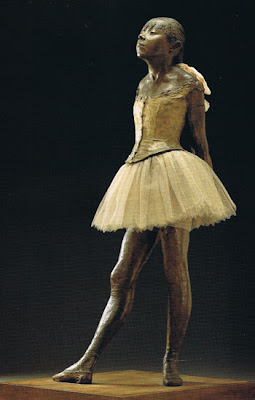
Dance was Degas’ obsession, throughout his life he examined and depicted figures with a hunger to show movement accurately and beautifully. He had no need to make money, his family were wealthy enough to support his vocation, and looking around the Royal Academy’s tribute to the artist, I wondered whether Degas ever intended these works to be displayed at all. Without the need and struggle to earn a living, Degas created art for his own enjoyment, his desire to realistically demonstrate figures in motion was a personal challenge.
The ‘Picturing Movement’ exhibition at the Royal Academy documents all aspects of the artist’s obsession through not only paintings and drawings but also photography and the influence this innovation had on his work is well covered. The earlier paintings were the most recognisable to me - demure scenes from the ballet rendered with a subdued palette. Though Degas shows examples of movement here, it is often calculated and carefully measured; sometimes the models were required to hold tricky en pointe poses for hours so Degas could capture ‘a single moment’.
His later work demonstrates an urgency - paintings that are busier, blurred and colourful; the looser brushstrokes show greater freedom and expression. A room is dedicated to the paintings of Russian dancers, an obvious preoccupation for him at the end of the 19th Century. They are wonderfully dramatic but show less of the romanticism of the earlier pictures, instead there is a sensuality which draws the viewer in. Whereas in the earlier paintings we are voyeurs at a private rehearsal watching the shy ballerinas, here the show is blasé, in your face, they want us to watch them performing and dancing.
My favourite aspect of this show is the lovely sculpture, of which ‘Little Dancer, aged fourteen’ is of course the most famous, the largest and most exquisite, made in painted bronze and adorned with delicate muslin and silk. It is also the only sculpture exhibited in Degas’ lifetime. It is spectacular to see such fragile ballerinas moving with fluidity and yet cast in the toughest most solid bronze, it is a curious juxtaposition of movement and material.
Degas’ work has a timeless beauty and dignity and this exhibition presents this, I would happily go again and again, to wander round in a dream.
Degas exhibition continues until 11 December, book here.
No comments:
Post a Comment